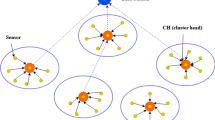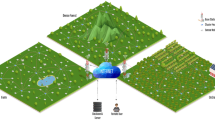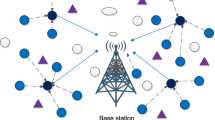Abstract
Wireless sensor networks (WSN) are part of our daily life as they play a vital role in applications of various domains. Energy optimization is a major challenge of WSN as they are operated through the battery. Data exchange is a significant and often performed operation in any WSN which has to be operated with less energy consumption. Bio-inspired clustering protocols are proving a success in minimizing energy consumption and are of current research interest by many researchers. This paper briefs on work carried on the classification of mushroom into edible or non-edible. Since most mushrooms are dangerous to health and may lead to death, henceforth is it is essential to identify the edibility of mushroom. Mushroom features identified by sensor such as ring, odur, spore_print_color, stalk_color_above, stalk_surface_above, and gill size are forwarded to base station (BS). Ant Lion optimization clustering algorithm (ALOC) is adopted in the routing of information to BS. ALOC avoids improper clustering reducing multiple messages at BS. The work is divided into two phases in the initial phase sensing of mushroom features and forwarding to BS is performed through WSN. In the second phase, the decision is taken whether mushroom is edible or not applying class-based association rules (CBA). The simulation results show ALOC is better than LEACH, ABC PSO and MLEACH through evaluation results in terms of network lifetime, energy consumption and retained alive nodes. correlation-based feature selection (CFS) with three filter search techniques: genetic algorithm (GA), evolutionary algorithm (EA), and particle swarm optimization (PSO) at BS as an evaluation method for selection of significant feature selection. CBA rules were generated using these subsets of significant features; hence resulted in a limited number of strong rules which are reliable and sufficient enough to classify the mushroom as edible or not. The patterns and rules generated using the proposed approach avoid the generation of duplicate and irrelevant rules and henceforth simplifies the analysis process using a reliable and interesting set of rules.









Similar content being viewed by others
References
Ahmed ESA, Ali BES, Osman EO, Ahmed TAM. Performance evaluation and comparison of IEEE 802.11 and IEEE 802.15.4 ZigBee MAC protocols based on different mobility models. Int J Future Gener Commun Netw. 2016;9(2):9–18.
News of bridge collapse at Minnesota, USA.2007 http://www.nytimes.com/2007/08/02/us/02bridge.html.
Akyildiz IF, Su W, Sankarasubramaniam Y, Cayirci E. A survey on sensor networks. IEEE Commun Mag. 2002;40(8):102–14.
Yamuna Devi CR, Shivaraj B, Manjula SH, Venugopal KR, Patnaik LM. EESOR: Energy efficient selective opportunistic routing in wireless sensor networks. Springer: Recent trends in computer networks and distributed systems security communications in computer and information science, vol. 420. New York: Springer; 2014. p. 16–31.
Xie R, Jia X. Transmission-efficient clustering method for wireless sensor networks using compressive sensing. IEEE Trans Parallel Distrib Syst. 2014;25(3):806–15.
Boughanmi N, Esseghir M, Merghem-Boulahia L, Khoukhi L. Energy efficient aggregation in wireless sensor networks, ICD/ERA, UMR 6279, Troyes University of Technology, 12 rue Marie Curie, 10000 Troyes. Berlin: Springer; 2013.
Devika G, Karegowda AG. Survey of WSN routing protocols. IJAEC. 2019;11(1):34–51 (article-3).
Chong C-Y, Kumar SP. Sensor networks: evolution, opportunities, and challenges. Proc IEEE. 2003;91(8):1247–56.
Youssef M, Youssef A, Younis M. Overlapping multi-hop clustering for wireless sensor networks. IEEE Trans Parallel Distrib Syst. 2009;20(12):1844–56.
Devika G, Karegowda AG. A pragmatic study of LEACH and its descendant routing protocols in WSN. Int J Comput Intell Inform. 2015;4(4):300–7.
Devika G, Premasudha BG, Karegowda AG. A comparative study of energy efficient hierarchical wireless sensor network protocols. Int J Appl Res Inf Technol Comput. 2015;6(3):189.
Valverde ME, Hernández-pérez T, Paredeslópez O. Review article edible mushrooms: improving human health and promoting edible mushrooms: improving human health and promoting. Int J Microbiol. 2015;2015:1–14.
Chowdhury DR, Ojha S. An empirical study on mushroom disease diagnosis: a data mining approach. Int Res J Eng Technol. 2017;4(1):530–4.
Mirjalili S. The ant lion optimizer. Elsevier Adv Eng Softw. 2015;83:80–98.
Yogarajan G, Revathi T. A discrete ant lion optimization (DALO) algorithm for solving data gathering tour problem in wireless sensor networks. Middle-East J Sci Res. 2016;24(10):3113–20.
Hall MA. Correlation-based feature selection for machine learning.PHD Thesis, Compuer science department, Waikota, 1999.
Alkronz ES, Moghayer KA, Meimeh M, Gazzaz M, Abu-Nasser BS, Abu-Naser SS. Prediction of whether mushroom is edible or poisonous using back-propagation neural network. Int J Acad Appl Res. 2019;3(2):1–8.
Verma SK, Dutta M. Mushroom classification using ANN and ANFIS algorithm. OSR J Eng. 2018;08(01):94–100.
Beniwal S, Das B. Mushroom classification using data mining techniques. Int J Pharma Bio Sci. 2015;6(1):1170–6.
Wibowo A, Rahayu Y, Riyanto A, Hidayatulloh T (2018) Classification algorithm for edible mushroom identification. In: 2018 international conference on information and communications technology (ICOIACT), Yogyakarta; 2018, pp. 250–253. https://doi.org/10.1109/ICOIACT.2018.8350746.
Pavankumar P, Agarwal R. CBIR: classification based association rules and approaches in datamining. Int J Pure Appl Math. 2018;119(18):689–702.
Pinky NJ, Mohidul Islam SM, Alice RS. Edibility detection of mushroom using ensemble methods. Int J Image Graphics Signal Process. 2019;4:55–62.
Han J, Kamber M. Data mining: concepts and techniques. The Morgan Kaufmann series in data management systems. San Francisco: Morgan Kaufmann; 2001.
Agresti A. An introduction to categorical data analysis. Wiley series in probability and mathematical statistics. 2nd ed. New Jersey: Wiley-Interscience; 2007.
Hosmer DW, Lemeshow S. Applied logistic regression. New York: Wiley; 1989.
Nizal I, Shaharanee M, Jamil J. Evaluation and optimization of frequent association rule based classification. Asia-Pac J Inf Technol Multimed. 2014;3(1):1–13.
Zhou XJ, Dillon TS. A statistical-heuristic feature selection criterion for decision tree induction. IEEE Trans Pattern Anal Mach Intell. 1991;13(8):834–41.
Ismail S, Zainal AR, Mustapha A (2018) Behavioural features for mushroom classification. In: 2018 IEEE symposium on computer applications & industrial electronics (ISCAIE). https://doi.org/10.1109/iscaie.2018.8405508.
Karegowda AG, Jayaram MA, Manjunath AS. Feature subset selection problem using wrapper approach in supervised learning. Int J Comput Appl (IJCA) Impact factor 08. 2010;1:13–7.
Karegowda AG, Manjunath AS, Jayaram MA. Comparative study of attribute selection using gain ratio and correlation based feature selection. Int J Inf Technol Knowl Manag IJTKM. 2010;3(2):271–7.
Karegowda AG, Jayaram MA, Manjunath AS. Feature subset selection using cascaded GA & CFS: a filter approach in supervised learning. Int J Comput Appl (IJCA). 2011;1:1–5.
Karegowda AG, Jayaram MA, Manjunath AS. Cascading k-means with ensemble learning: enhanced categorization of diabetic data. J Intell Syst. 2012;23(3):237–54.
Karegowda AG. Enhanced categorization of wheat seeds by integrating ensemble methods with decision tree identified significant features. Int J Data Min Emerg Technol. 2014;4(1):10–5.
Karegowda AG, Jayaram MA. Significant feature set driven, optimized FFN for enhanced classification. Int J Comput Intell Inform. 2013;2(4):248–55 (ISSN: 2231-0258, ISSN: 2231-0258).
Kandris D, Nakas C, Vomvas D. Applications of wireless sensor networks: an up-to-date survey. Appl Syst Innov. 2020;3:14. https://doi.org/10.3390/asi3010014.
Wang Y, Du J, Zhang H, Yang X. Mushroom toxicity recognition based on multigrained cascade forest. Sci Program. 2020. https://doi.org/10.1155/2020/8849011 (Article ID 8849011).
Author information
Authors and Affiliations
Corresponding author
Ethics declarations
Conflict of interest
Authors declare that they have no conflict of interest.
Additional information
Publisher's Note
Springer Nature remains neutral with regard to jurisdictional claims in published maps and institutional affiliations.
This article is part of the topical collection “Soft Computing and its Engineering Applications” guest edited by Kanubhai K. Patel, Deepak Garg, Atul Patel and Pawan Lingras.
Rights and permissions
About this article
Cite this article
Devika, G., Ramesh, D. & Karegowda, A.G. Mushroom Edibility Identification Applying CBR and Ant Lion Techniques in Multi-sensor Environment. SN COMPUT. SCI. 2, 225 (2021). https://doi.org/10.1007/s42979-021-00582-z
Received:
Accepted:
Published:
DOI: https://doi.org/10.1007/s42979-021-00582-z




